It was a cold day in January 2004 when an eager group of rockhounds gathered in a northeast
Georgia pine forest to do battle with mother earth. We had come together from near and far
to hunt for ever-elusive amethyst that seldom surrenders without a good fight.
We arrived at the early in the morning on January 16, 2004.
This "machine" dig was by invitation only and was attended by a select group of
friends including Mike Galvin, Dave Smith, Don Brockway, David Reville, Chrissy Streeter (my wife) and myself.
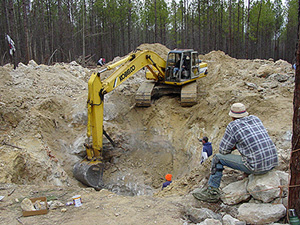
The bigger trackhoe in action
Click on the above picture to enlarge
Two large trackhoes were used to remove an overburden of soil, saprolite and competent bedrock.
The larger Kobelco trackhoe weighs 50,000 pounds and is able to pick up about 1.2 cubic yards
of material in a single scoop and dig to a depth of 25 feet below grade. The smaller IHI 555J
trackhoe weighs a mere 13,000 pounds and is able to dig approximately 13 feet below grade.
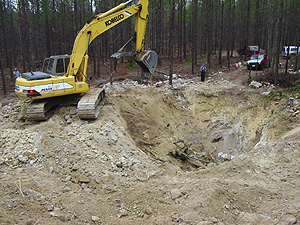
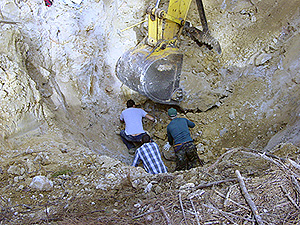
View of hole from the rear (above left)
Inspecting underside of boulder for pockets
before extraction (above right)
We all hoped to find pockets within the saprolite and bedrock that contained amethyst crystals.
When a decent clay-filled pocket with amethyst was spotted in the pit, the machine was halted
and all the digging had to be painstakingly performed by hand so the crystals would not be
damaged.
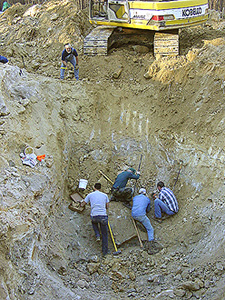
The crew working a pocket by hand
Click on the above picture to enlarge
There were loose crystals and matrix pieces in smaller pockets to be found by sorting
through soils and breaking up boulders that had been excavated.
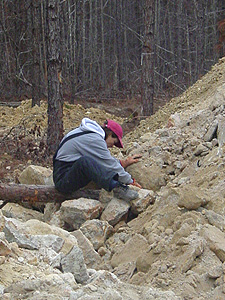
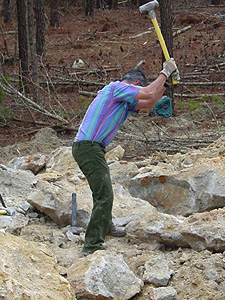
Chrissy sorting through the loose material (above left)
Dave putting the hurt to a
poor defenseless boulder (above right)
As a geologist, I am always interested in the geology of an area that we rockhound. The bedrock
is metadacite (metamorphosed dacite). The soft decomposed rock (formerly
metadacite) that is generally above the bedrock, rich in clay and remaining its
original place is called saprolite. The metadacite and saprolite both contain quartz pockets.
Dacite is an extrusive igneous rock made up mostly of quartz but also contains plagioclase
feldspar, pyroxene, and amphibole. Dacite generally forms as a thick rounded lava flow
in the shape of a dome when it erupts from a volcano's surface. Dacite lava was most likely
extruded during the late Precambrian to the early Paleozoic Eras in response to plate
tectonic forces. As is common, the volcanic rock must have contained voids that would later
become the sites for quartz crystallization. The dacite was metamorphosed during several
Paleozoic tectonic events to become metadacite. Granite plutons that outcrop as near as 5
miles to the northwest were likely intruded during a Late Paleozoic tectonic event. These
granites likely produced silica-rich hydrothermal fluids that made their way through fractures
to deposit quartz crystals in the pre-existing voids within the metadacite. Several different
varieties of quartz (clear, cloudy and amethyst) occur at the site indicating that there must
have been at least three separate hydrothermal phases. Subsequent near-surface weathering of
feldspar and the oxidation of iron rich minerals produced clay. This clay was transported by
meteoric water through fractures and deposited in most of the quartz-lined pockets.
The highlight of the two days was the discovery of a large pocket in a monster boulder that
had been plucked from the hole. The pocket is lined with a druze of needle-like quartz
crystals. Amidst the sparkling druze are several incredible clusters of dark purple amethyst
crystals. We all agreed that this was the finest specimen of matrix amethyst from Georgia
that any of us had ever seen. We hope that this complete amethyst pocket still in the rock
will hopefully find its final resting spot in a museum where it can be appreciated by
rockhounds for years to come. The following pictures were taken of the yet-to-be-cleaned
specimen so you can only imagine how magnificent it will look when all the dirt is washed
away from the crystals.
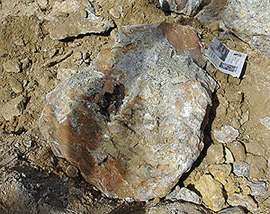
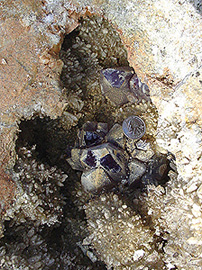
Whole Rock (above left) & Pocket Close-up (above right)
Click on each specimen picture to enlarge
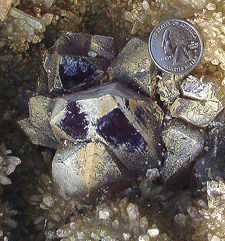
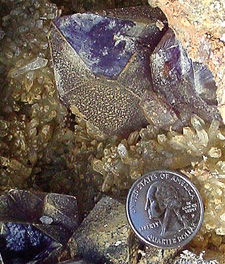
Close-ups of pocket (above)
Late Saturday afternoon, we came to realize that it was time to stop. Dark clouds were starting
to form on the horizon and the weather forecast called for heavy rains that would start that
evening and continue throughout the next day. The massive hole would have to be filled and the
area graded before nightfall. While David started filling the hole with the Kobelco, we divided
all the loot, making sure that our good-natured trackhoe operator was well compensated with
crystals for his skill and enthusiasm.
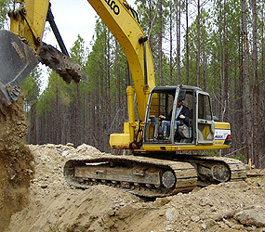
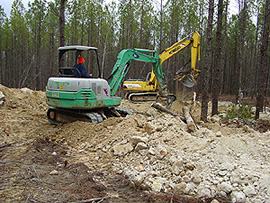
Dumping the dirt and rocks back into the hole (above left)
Dueling trackhoes (above right)
The results of the dig surpassed even our most optimistic expectations.
We found numerous large pockets containing abundant dark and light purple, gem-quality amethyst,
including loose crystals, clusters and matrix specimens.
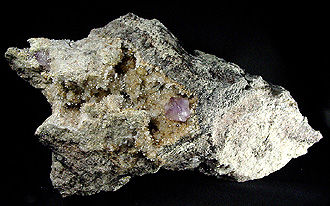
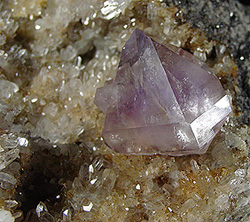
Click on each specimen picture to enlarge
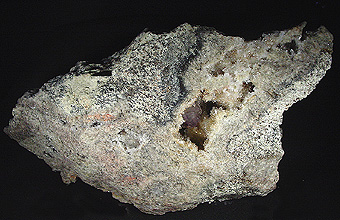
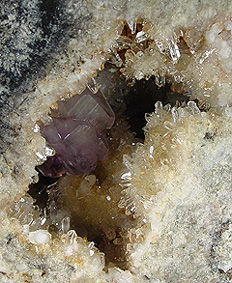
Click on each specimen picture to enlarge
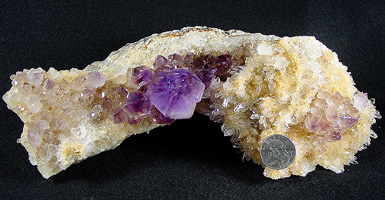
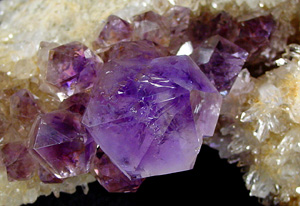
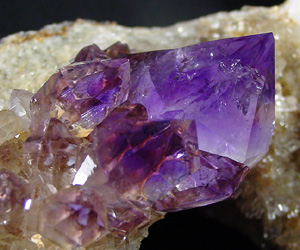
Click on each specimen picture to enlarge
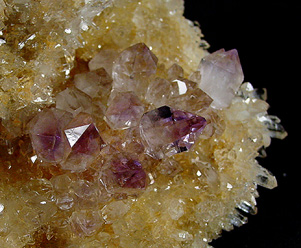
Click on each specimen picture to enlarge
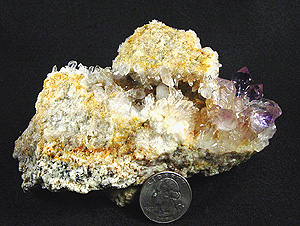
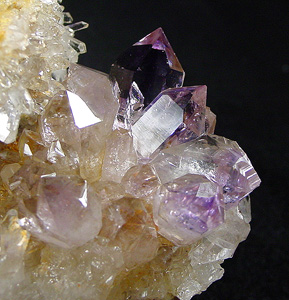
Click on each specimen picture to enlarge
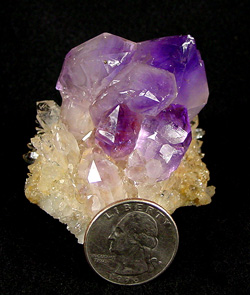
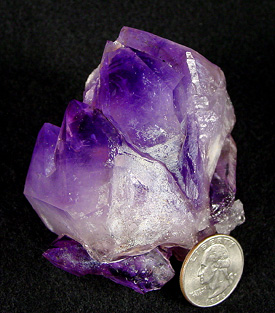
Click on each specimen picture to enlarge
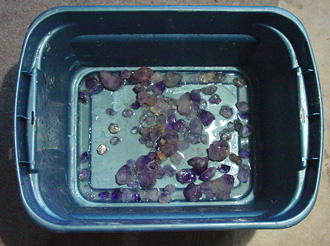
We were exhilarated by the knowledge that we had recovered some of the finest Georgia
amethyst crystals ever found. We all drove away from the site with bulging buckets and
big smiles on our faces.
CLICK THE LITTLE MINER TO RETURN TO THE FIELD TRIP PAGE
